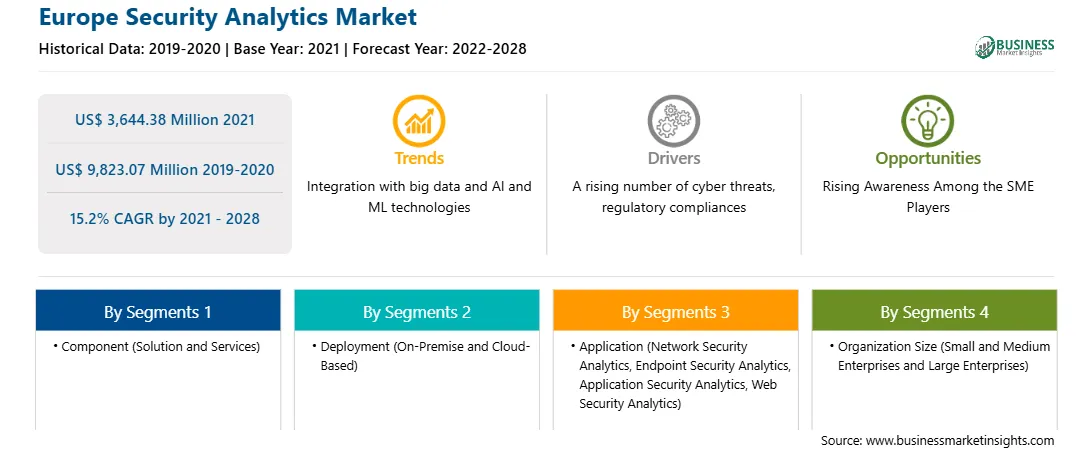The surge in telecomputing has potentially increased the use of vulnerable devices and services, including virtual private networks (VPN), posing a threat to any organization. With the rising use of the Internet, the demand for telecomputing is also increasing in businesses. Furthermore, during the COVID-19 outbreak, businesses have to follow the government norms of remote working. Thus, the number of virtual private networks (VPNs) increased to facilitate data sharing and connecting all devices together. Also, online communication platforms, such as Zoom and Skype, have witnessed a substantial rise across several organizations, making business processes vulnerable against malicious activities and ransomware and phishing attacks, as they are more exposed to open platforms. These situations have led to offering customized and robust analytics-driven security solutions to organizations. For instance, Unify Square, Inc. offers PowerSuite tool that helps manage, amplify, and secure business environment with Zoom analytics solutions. Hence, with the growing adoption of advanced technologies, security analytics systems have also increased, resulting in significant growth in the Europe market.
In 2020, the impact of the COVID-19 outbreak differed from country to country across the European region as selected countries witnessed an increase in the number of recorded cases and subsequently attracted strict and longer lockdown periods or social isolation. However, its impact on Western European countries, such as Germany, France, and the UK, was comparatively modest because of their robust healthcare systems. To protect citizens from the virus, the European governments have made tremendous investments in incorporating technologies in healthcare systems to help identify signs of the virus. In 2021, the offices resumed operations after releasing lockdown measures and the ongoing vaccination process.
The COVID-19 pandemic has negatively impacted almost every industry. However, the security industry of information and communications technology was not affected as other industries since businesses allowed their employees to work from home. Due to work-from-home facilities, organizations are realizing the importance of security analytics systems to give businesses the ability to foresee security threats using analytics software. Its value has increased exponentially during the COVID-19 pandemic as threats could destroy the infrastructure of a business and its systems. All these factors are contributing to the positive growth of the security analytics market in the region.
With the new features and technologies, vendors can attract new customers and expand their footprints in emerging markets. This factor is likely to drive the Europe security analytics market. The Europe security analytics market is expected to grow at a good CAGR during the forecast period.
Strategic insights for the Europe Security Analytics provides data-driven analysis of the industry landscape, including current trends, key players, and regional nuances. These insights offer actionable recommendations, enabling readers to differentiate themselves from competitors by identifying untapped segments or developing unique value propositions. Leveraging data analytics, these insights help industry players anticipate the market shifts, whether investors, manufacturers, or other stakeholders. A future-oriented perspective is essential, helping stakeholders anticipate market shifts and position themselves for long-term success in this dynamic region. Ultimately, effective strategic insights empower readers to make informed decisions that drive profitability and achieve their business objectives within the market.

| Report Attribute | Details |
|---|---|
| Market size in 2021 | US$ 3,644.38 Million |
| Market Size by 2028 | US$ 9,823.07 Million |
| Global CAGR (2021 - 2028) | 15.2% |
| Historical Data | 2019-2020 |
| Forecast period | 2022-2028 |
| Segments Covered |
By Component
|
| Regions and Countries Covered | Europe
|
| Market leaders and key company profiles |
The geographic scope of the Europe Security Analytics refers to the specific areas in which a business operates and competes. Understanding local distinctions, such as diverse consumer preferences (e.g., demand for specific plug types or battery backup durations), varying economic conditions, and regulatory environments, is crucial for tailoring strategies to specific markets. Businesses can expand their reach by identifying underserved areas or adapting their offerings to meet local demands. A clear market focus allows for more effective resource allocation, targeted marketing campaigns, and better positioning against local competitors, ultimately driving growth in those targeted areas.

The Europe Security Analytics Market is valued at US$ 3,644.38 Million in 2021, it is projected to reach US$ 9,823.07 Million by 2028.
As per our report Europe Security Analytics Market, the market size is valued at US$ 3,644.38 Million in 2021, projecting it to reach US$ 9,823.07 Million by 2028. This translates to a CAGR of approximately 15.2% during the forecast period.
The Europe Security Analytics Market report typically cover these key segments-
The historic period, base year, and forecast period can vary slightly depending on the specific market research report. However, for the Europe Security Analytics Market report:
The Europe Security Analytics Market is populated by several key players, each contributing to its growth and innovation. Some of the major players include:
The Europe Security Analytics Market report is valuable for diverse stakeholders, including:
Essentially, anyone involved in or considering involvement in the Europe Security Analytics Market value chain can benefit from the information contained in a comprehensive market report.